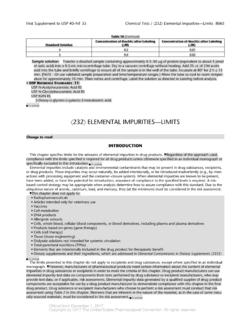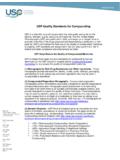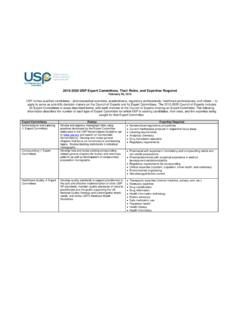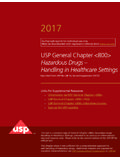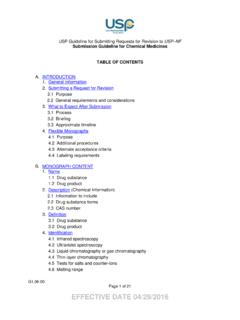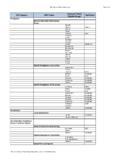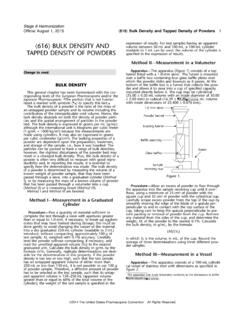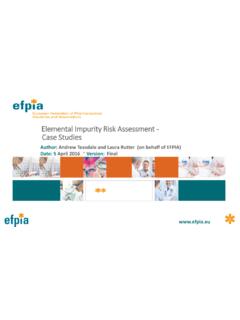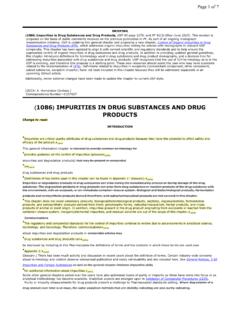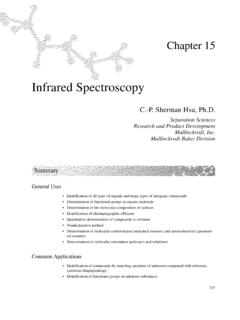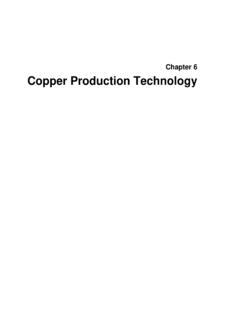Transcription of 476 Organic Impurities in Drug Substances and Drug …
1 40(3) In-Process Revision: <476> Organic Impurities IN drug Substances .. Page 1 of 4. BRIEFING. 476 Organic Impurities in drug Substances and drug Products. As part of an ongoing monograph modernization initiative, the United States Pharmacopeial Convention (USP) is updating general chapter Impurities in drug Substances and drug Products 1086. and proposing this new chapter that addresses Organic Impurities testing for articles subject to applicable monographs in compendia of the USP, including the United States Pharmacopeia National Formulary. This new chapter has been created to align with current scientific and regulatory approaches and to help ensure the appropriate control of Organic Impurities and degradation products in drug Substances and drug products.
2 The goal is to provide a science-based approach for the control of Impurities in relevant monographs, and thereby to ensure the quality of the product as it relates to safety and efficacy. Over time, the current general chapter Ordinary Impurities 466 may be used less frequently and may be withdrawn. (GCPA: A. Hernandez-Cardoso.). Correspondence Number C133393. Comment deadline: July 31, 2014. Add the following: 476. INTRODUCTION. This chapter covers formal requirements for controlling Organic process Impurities and degradation products in drug Substances , and degradation products in drug products. Impurities are critical quality attributes of drug Substances and drug products because they have the potential to affect safety and efficacy.
3 Therefore, all drug Substances and drug products are subject to control of Impurities . When a detected impurity is not described in the individual monograph, the manufacturer is responsible for developing appropriate specifications (analytical procedures and acceptance criteria). For medicines marketed in the United States, drug Substances and drug products covered by this chapter can, in general, be placed in one of two categories: (1) those that are covered by ICH and/or Food and drug Administration (FDA) guidances, for example, most New drug Application (NDA) and Abbreviated New drug Application (ANDA) products; and (2) those that are not covered by drug applications, for example, over-the-counter (OTC) products.
4 Impurities that arise from excipients present in the drug product or that are leached from the container closure system are not covered in this chapter. Also excluded from this chapter are 4/30/2014. 40(3) In-Process Revision: <476> Organic Impurities IN drug Substances .. Page 2 of 4. veterinary products, biological/biotechnological products, peptides, oligonucleotides, fermentation products and semisynthetic products derived from them, radiopharmaceuticals, herbal products, and crude products of animal or plant origin. These products are excluded from this chapter because Impurities of these types of drug Substances and drug products may require special considerations.
5 Current regulatory guidance documents, such as those from ICH, and sound scientific principles may be used to control the level of Impurities in products that are excluded from this chapter. Also excluded from this chapter are the following: z Extraneous contaminants that should not occur in drug Substances or drug products and are more appropriately addressed as good manufacturing practice issues z Polymorphic forms z Impurities arising from residual solvents (see Residual Solvents 467 ). z Elemental Impurities (see Elemental Impurities Limits 232 Elemental Impurities Procedures 233 ). IDENTIFICATION OF Impurities IN drug Substances AND drug PRODUCTS.
6 drug substance and drug product Organic Impurities shall include process-related Impurities that result from the manufacturing process, and degradation products observed during manufacture and stability studies. Identification of Impurities shall be based on sound scientific appraisal of potential degradation pathways in the drug substance and drug product , including those Impurities that arise from interactions of the drug with the environment, excipients, or the primary container closure system. Impurities observed in stability studies conducted at the recommended storage conditions shall be identified when above the identification threshold, which can be established using currently applicable regulations or other scientific means.
7 Impurities present at a level below the identification threshold generally do not require identification. ANALYTICAL PROCEDURES FOR Impurities AND DEGRADATION PRODUCTS. Manufacturers shall validate analytical procedures and demonstrate their suitability for the detection and quantitation of Impurities . Manufacturers of drug Substances and drug products shall refer to current applicable regulatory guidances and shall develop control strategies for establishing acceptance criteria for Impurities . These acceptance criteria shall be justified with appropriate safety considerations. Analytical procedures for OTC drug products may require a case-by-case approach, 4/30/2014.
8 40(3) In-Process Revision: <476> Organic Impurities IN drug Substances .. Page 3 of 4. depending on the diversity and complexity of dosage forms. These procedures shall be verified or validated and shall be suitable for their intended purpose. For Impurities that are known or suspected to be highly toxic ( , genotoxic) or that produce undesired pharmacological effects, the quantitation/detection limit of the analytical procedures shall be commensurate with the acceptance criteria. REPORTING Impurities AND DEGRADATION PRODUCTS. Impurities present at a level above the reporting threshold ( , the disregard limit) shall be reported according to the relevant analytical method(s).
9 The reporting threshold can be established using currently applicable regulations/guidances or other acceptable scientific means. Quantitative test results shall be reported as numerical values and rounded according to conventional rules (see General Notices ). Impurities at a level greater than the reporting threshold shall also be summed and reported as total Impurities . SETTING ACCEPTANCE CRITERIA FOR Impurities AND DEGRADATION PRODUCTS. Acceptance criteria shall be set for all Impurities expected to be present at levels above the reporting thresholds, and these criteria shall be based on an applicable guidance or on scientific rationale. Acceptance criteria should not be based solely on process capability.
10 Acceptance criteria shall cover the drug substance through its intended period of use and the drug product through its shelf life. Generally, drug substance Impurities need not be monitored or specified in drug products unless they are also degradation products. The acceptance criteria shall include the following, where applicable: z Each specified identified impurity and degradation product z Each specified unidentified impurity and degradation product z Any unspecified impurity or degradation product with an acceptance criteria NMT the identification threshold z Total Impurities and degradation products. For a given impurity, manufacturers shall establish the acceptance criteria based on its qualified level, its increase during stability studies and proposed shelf life, and its labeled storage conditions.
